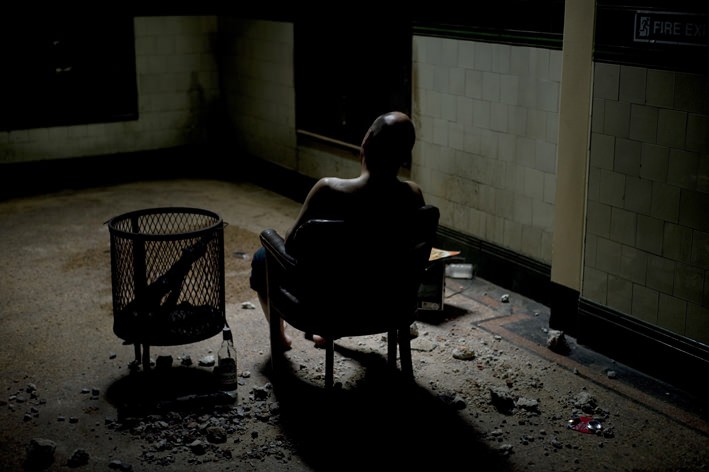Omer Fast: Nostalgia
A solo show by Omer Fast
gb agency
From September 18 to November 13, 2010
gb agency is pleased to present a solo exhibition by Omer Fast offering two works for the first time in France: his video Nostalgia and the installation The Forlorn Lover’s Guide to the Underground and to Doubles.
The three-part scenario of Nostalgia is based on a memory that gets told, passed on and reformulated several times. Each of the three chapters (three films) appears in its own space, and the viewer travels spatially and physically through the story. The origin of the work is a conversation between the artist and a Nigerian political refugee in London. Nostalgia portrays that conversation all the while creating a new fiction.
To start the work, the first video Nostalgia I shows a man moving around in the woods. His voiceover tells the story: a difficult and solitary childhood in a war torn country and his meeting with a mentor who teached him many things including how to hunt partridge. The pictures are shaky, the camera wobbles, the style is clumsy, and the video appears to be amateur.
Further on, we see in Nostalgia II a meeting between a filmmaker (or an artist) and a young man. The filmmaker asks the man to tell his story, about a young African in the UK who seeks political asylum. Two video monitors side by side replicate the dialogue between the two men. The installation becomes complex and the images more polished. After a series of mixed up comments and misunderstandings, both focus on a childhood memory: the story of how the father taught his son to make traps to catch partridge.
The final part of the piece Nostalgia III is more cinematographic. Shot on 16mm, it’s reminiscent of a 1970s sci-fi movie: an emigrant from post-apocalyptic Europe is arrested on the coast of West Africa. Omer Fast combines disparate elements, using opposition and anachronism with a futurist vision, retro treatments, geopolitical shifts to conduct the viewer through a tender and violent tale. First the asylum seeker is interrogated by the local authorities, then let go in exchange for information on the underground gang and its secrets, then other reverse illegal immigrants are captured in a tunnel. The story is sidetracked by the memory of the bird traps which is told by other characters in the film.
While Nostalgia addresses the idea of displacement — mental or physical — its focus is mainly the transformation of memory: from an intimate experience to the story of it, and from room to room memory becomes a story to be told. Reality becomes instrumentalized by numerous realities, moments and places. The arrangement of the installation reflects the multiple points of view.
The Forlorn Lover’s Guide to the Underground and to Doubles is the first ever non-video installation by Omer Fast. It includes more than forty items: texts, photos, drawings, photocopies and documents. The rhizomic placement of the elements is designed around Omar al-Gougle, the central character of a story with multiple entry points. Different narratives are intertwined, cross over and even contradict one another. If the totality of the stories produces a closed loop system, the images and illustrations present openings to different perspectives.
From the ‘Tomb of the Patriarchs’ in Hebron to Edison’s ‘camera obscura’, the viewer is caught in a maze of data, both real and fictional. There is a current of rumor throughout the installation: a successful writer, Omar al-Gougle has allegedly killed himself following the appearance of a bad review of his latest book. An attack by members of a group known as ‘The Wheatherman’— which has appeared in another work by the artist — is oddly linked to Hollywood through the actor Dustin Hoffman. The activism of the 1970s brushes up against today’s terrorism in the Middle East.
Thus the artist de-hierarchizes information, the historic and the anecdotal become equalized, and fiction can’t be separated from reality in the telling of this obscure life of Omar al-Gougle. If CNN Concatenated thrashed television news, and if historic reconstruction was revealed as obsolete in Godville, then The Forlorn Lover’s Guide to the Underground and to Doubles deflates internet media and belittles the findings of its search engines. As with other works by Fast, the piece displays a fine precision of terms and a broad creativity of composition.
This exhibition reveals certain new directions for the artist — especially in Nostalgia III — while still affirming his fundamental principles.
Nostalgia was co-produced by South London Gallery, UC Berkeley Art Museum and Pacific Film Archive and Verein der Freunde der Nationalgalerie, Berlin.





